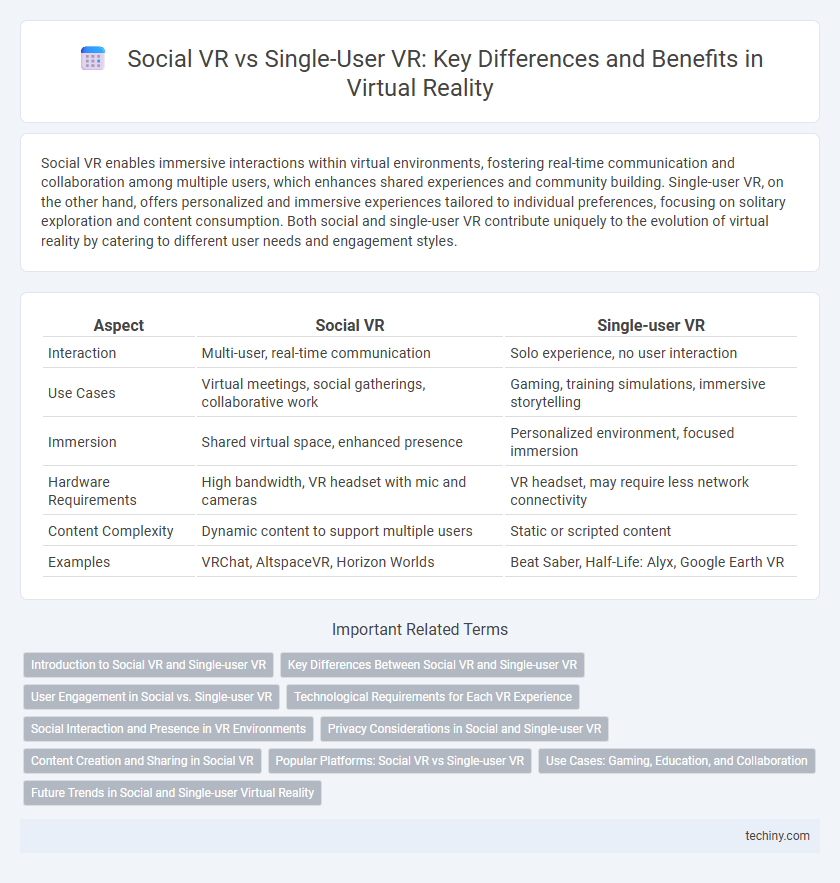Social VR enables immersive interactions within virtual environments, fostering real-time communication and collaboration among multiple users, which enhances shared experiences and community building. Single-user VR, on the other hand, offers personalized and immersive experiences tailored to individual preferences, focusing on solitary exploration and content consumption. Both social and single-user VR contribute uniquely to the evolution of virtual reality by catering to different user needs and engagement styles.
Table of Comparison
| Aspect | Social VR | Single-user VR |
|---|---|---|
| Interaction | Multi-user, real-time communication | Solo experience, no user interaction |
| Use Cases | Virtual meetings, social gatherings, collaborative work | Gaming, training simulations, immersive storytelling |
| Immersion | Shared virtual space, enhanced presence | Personalized environment, focused immersion |
| Hardware Requirements | High bandwidth, VR headset with mic and cameras | VR headset, may require less network connectivity |
| Content Complexity | Dynamic content to support multiple users | Static or scripted content |
| Examples | VRChat, AltspaceVR, Horizon Worlds | Beat Saber, Half-Life: Alyx, Google Earth VR |
Introduction to Social VR and Single-user VR
Social VR environments enable multiple users to interact in shared virtual spaces, enhancing collaboration, communication, and immersive social experiences through avatars and real-time audio or video. Single-user VR focuses on individual experiences, offering personalized interactions with virtual objects or narratives without live user engagement. Both modalities leverage advanced VR hardware and software, with Social VR emphasizing connectivity and community, while Single-user VR prioritizes immersion and user-driven exploration.
Key Differences Between Social VR and Single-user VR
Social VR platforms facilitate real-time interaction among multiple users in immersive environments, enhancing collaborative experiences and social presence. Single-user VR offers personalized, solitary experiences focused on individual exploration or training without social engagement complexities. Key differences include the level of user interaction, content design tailored for group dynamics versus solo use, and distinct hardware requirements supporting multi-user connectivity versus standalone functionality.
User Engagement in Social vs. Single-user VR
Social VR environments significantly enhance user engagement by enabling real-time interaction, collaboration, and shared experiences, fostering a sense of presence and community. In contrast, single-user VR often concentrates on immersive solitary exploration and task completion, limiting social connectivity but deepening personal focus and narrative involvement. Metrics such as session duration, frequency of user-generated content, and communication activity highlight the increased engagement levels found in social VR platforms compared to single-user experiences.
Technological Requirements for Each VR Experience
Social VR demands advanced network infrastructure with low latency and high bandwidth to maintain real-time interactions among multiple users, alongside sophisticated avatar rendering and spatial audio systems. Single-user VR prioritizes high-performance standalone hardware with powerful processors and graphic capabilities to deliver immersive, seamless experiences without the need for constant connectivity. Both experiences require precise motion tracking and ergonomic VR devices, but social VR emphasizes multi-user synchronization technologies for shared environments.
Social Interaction and Presence in VR Environments
Social VR environments enhance presence by enabling real-time interaction and communication between multiple users, fostering a shared sense of space and community. Single-user VR emphasizes immersive personal experiences but lacks dynamic social feedback, which can reduce the feeling of connectedness and presence. Advances in avatar representation and spatial audio in Social VR contribute to stronger social bonds and more natural interactions within virtual environments.
Privacy Considerations in Social and Single-user VR
Social VR environments demand heightened privacy protocols due to real-time interaction and data sharing among multiple users, increasing risks of data breaches and unauthorized surveillance. Single-user VR experiences primarily focus on securing personal data and preventing unauthorized access to sensitive user information stored locally or in the cloud. Robust encryption standards and customizable privacy settings are essential to protect user identity and behavior across both VR types, with social VR requiring augmented measures for user-generated content and communication channels.
Content Creation and Sharing in Social VR
Social VR platforms enable users to collaboratively create and share immersive content in real-time, fostering interactive experiences that extend beyond individual engagement. Content creation tools integrated within Social VR support multi-user input, allowing for dynamic modifications and shared storytelling that single-user VR lacks. The ability to seamlessly distribute and co-experience user-generated content highlights Social VR's advantage in enhancing creativity and social connectivity.
Popular Platforms: Social VR vs Single-user VR
Popular platforms in Social VR include VRChat, Rec Room, and Horizon Worlds, which emphasize interactive multiplayer experiences and user-generated content. Single-user VR primarily features platforms like Oculus Rift, HTC Vive, and PlayStation VR, focusing on immersive solo gameplay and narrative-driven applications. Social VR fosters community engagement and collaboration, while single-user VR centers on personalized exploration and entertainment.
Use Cases: Gaming, Education, and Collaboration
Social VR platforms enhance multiplayer gaming experiences by enabling real-time interaction and shared virtual environments, fostering teamwork and competition. In education, Social VR facilitates immersive group learning, virtual classrooms, and collaborative projects, increasing engagement and knowledge retention. Single-user VR excels in personalized gaming, focused skill training, and self-paced educational modules, providing tailored environments without social distractions.
Future Trends in Social and Single-user Virtual Reality
Future trends in Social VR emphasize enhanced multi-user interactions through advanced avatars, spatial audio, and persistent virtual environments that support collaboration and social presence. Single-user VR is evolving with more immersive storytelling, AI-driven adaptive experiences, and improved haptic feedback for deeper sensory engagement. Hybrid models integrating social and solo elements are emerging, leveraging cloud computing and 5G connectivity to dynamically balance shared and individual experiences in virtual spaces.
Social VR vs Single-user VR Infographic

 techiny.com
techiny.com